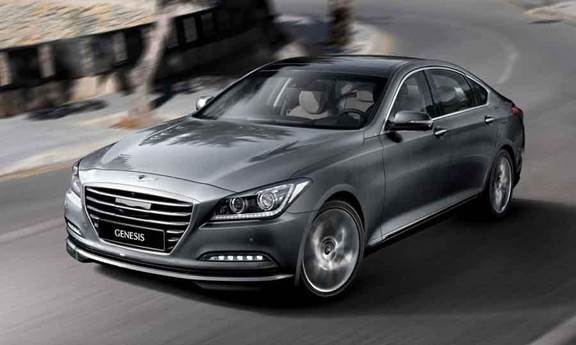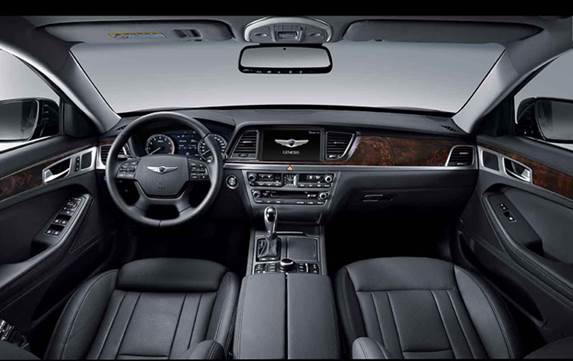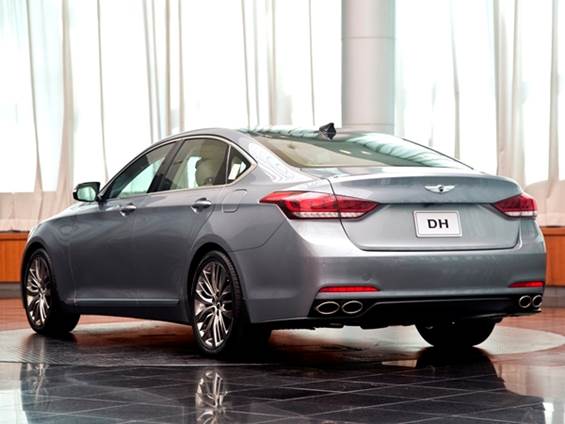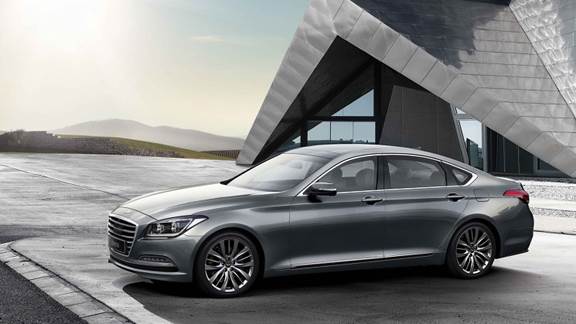The title of this story might seem like a cheap Old Testament gag, but this gen-two Genesis actually represents a departure. Hyundai no longer must beg for a place at the big kids’ table, hoping that premium features, refinement, and a low price might lure Mercedes, BMW, and Lexus buyers who didn’t care that valets wouldn’t park their cars in front.

The plain-looking Genesis launched in 2009 alongside the swoopy Sonata that unveiled Fluidic Sculpture, Hyundai’s first unique design. Now Fluidic Sculpture 2.0, previewed by the recent HCD-14 concept, arrives on the 2015 Genesis. Design chief Casey Hyun says it “tells its story with fewer lines and greater contrast of surfacing for a more voluptuous look.” Length increases 0.2 inch on a 3.0-inch-longer wheelbase, shrinking overhangs by 1.6 and 1.2 inch front and rear. Moving the front wheels forward and the windshield aft heightens the long hood/cab-rear proportion that looks so expensive.
The engineering team expended biblical efforts on the car’s ride and handling, optimizing aerodynamics, engine mounts, and body structure. The last is now made of 51.5 percent high-strength steels said to make it stiffer than a BMW 535i. The five-link front suspension geometry was revised, while the rear lateral stiffness got a 39 percent boost to sharpen dynamic response. While the previous car’s jounce and rebound rates were nearly identical, the new car employs stiffer rebound tuning to help control roll. Hyundai’s first rack-mounted, belt-driven electric power steering is paired with a variable-ratio rack, but effort and direction change ramp up faster off center. The longer wheelbase also improves weight distribution by a percent to 52/48 front rear.

New HTRAC all-wheel drive uses a wet-clutch center diff that splits torque 40/60 front/rear normally, 90/10 when slippery, 10/90 in Sport mode handling, and 0/100 in Eco mode. Direct-injected 3.8-liter V-6 and 5.0-liter V-8 engines and Hyundai’s eight-speed automatic transmission carry over, and frankly Genesis’ efficiency efforts could have used some revelation. Sure, its stiffer steel allows the enlarged and stronger body to shed 33 pounds, but adding features two by two means this ark gained about 130 pounds, not counting HTRAC’s 140 pounds.
Collision mitigation applies full braking below 50 mph or taps the binders to warn of trouble above that speed. Lane-keeping assist offers three modes: vibrate the wheel to warn, steer to stay in the lane, or steer back into the lane after departing it. Stand near the deck lid for 3 seconds and it opens with no foot-waving; soft-close doors are optional; a 9-inch color head-up display shows blind-spot warnings; and a CO2 sensor disables recirc mode at 2500 parts/million to prevent drowsiness.

Judging from a brief proving-ground spin in pilot-built examples driven alongside a first-gen Genesis, a 535i, and an E350 4Matic, the car looks, feels, and drives like a bigger one, and its interior seems much fancier. The V-6 feels smoother than the BMW’s I-6, but neither Hyundai engine could outrun that twin-turbo. The trans shifts smoother than either German’s, but was reluctant to downshift, even when paddled. Two laps of an unfamiliar handling circuit provided no solid conclusions, but the level of body roll and steering feedback didn’t exactly scream “sport sedan.”

But just because Hyundai compares it with autobahn-stormers doesn’t mean we need to. This Genesis will be a more delightful car than its predecessor when driven moderately, which – along with its dashing design – should be enough to inspire some religious fervor on the sales charts.
Specifications Price: $36,000 Vehicle layout: Front-engine, RWD/AWD, 5-pass, 4-door sedan Engines: 3.8L/333-hp (est)/ 291-lb-
(est) DOHC V-6; 5.0L/429-hp (est)/376-lb-
(est) DOHC V-8 Transmission: 8-speed automatic Curb weight: 3950-4300 lb Wheelbase: 118.5 in 0-60 mph: 4.8-6.2 sec |